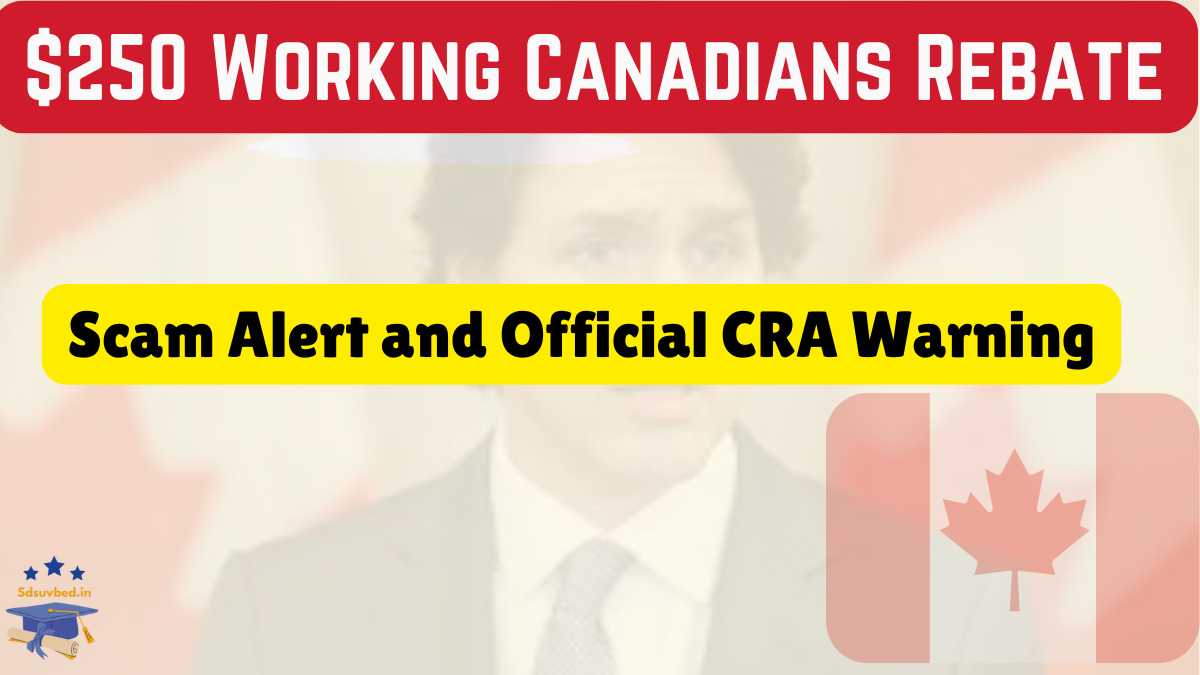The Working Canadians Rebate (WCR) was introduced on November 21, 2024, by the Liberal government as part of an economic relief package. Designed to provide financial assistance, the rebate offers a one-time payment of $250 to eligible individuals who worked in 2023 and earned up to $150,000.

Key Details About the Rebate
- Eligibility: Canadians who worked in 2023 and earned up to $150,000.
- Expected Delivery: Spring 2025, pending legislative approval.
- Purpose: To help working Canadians with rising living costs.
- Potential Reach: Approximately 18.7 million Canadians could qualify for this rebate.
Although the rebate was announced, the legislation required to implement it is still pending, causing a delay in its rollout.
How Are Scammers Exploiting the $250 Rebate?
The delay in passing the legislation has opened the door for scammers to target unsuspecting Canadians. Fraudulent emails, text messages, and phone calls claim to offer early access to the rebate in exchange for personal or financial information.
Common Scam Tactics:
- Fake Claims: Promises of early rebate access for a fee or personal information.
- Urgent Language: Scammers pressure victims to act quickly, threatening consequences if they don’t comply.
- Impersonation: Fraudsters use official-looking logos and professional language to appear credible.
What Is the CRA’s Official Warning?
The Canada Revenue Agency (CRA) has issued a clear warning:
- No Payments Yet: The rebate will only be distributed once legislation is passed.
- Automatic Distribution: Payments will be made automatically via direct deposit or cheque. No application is required.
- No Fees: The CRA will never ask for fees or personal information via email or text messages.
What the CRA Will Never Do:
- Send unsolicited emails or texts asking for sensitive information.
- Demand payment via gift cards, cryptocurrency, or prepaid credit cards.
- Use threatening or aggressive language to force compliance.
How Can You Identify Scam Attempts?
The CRA has outlined red flags to help Canadians spot fraudulent communications:
Urgent Requests for Payment:
Scammers may demand immediate payments, claiming it’s necessary to receive the rebate or avoid penalties. The CRA does not operate this way.
Requests for Unusual Payment Methods:
Be cautious if asked to pay via gift cards, Interac e-transfers, or cryptocurrency. These methods are not used by the CRA.
Threatening or Aggressive Language:
Messages threatening arrest or deportation for non-payment are scams. The CRA does not use intimidation tactics.
In-Person Meetings:
Scammers may attempt to arrange in-person meetings to collect payment. The CRA does not conduct in-person collection for rebates.
What Should You Do If You Suspect a Scam?
If you encounter suspicious messages or phone calls claiming to be from the CRA:
- Do Not Respond: Avoid clicking links or downloading attachments from unsolicited messages.
- Verify the Message: Contact the CRA directly using official channels to confirm legitimacy.
- Report the Scam: Report suspicious activity to the CRA’s Anti-Fraud Centre to help prevent others from falling victim.
How Will the CRA Distribute the $250 Rebate?
Once legislation for the rebate is passed, the CRA will automatically distribute the payment:
- Direct Deposit: Funds will be deposited into eligible individuals’ bank accounts.
- Cheque: Those without direct deposit will receive a cheque by mail.
No additional forms, fees, or actions are required to receive the rebate. Canadians should only rely on official CRA channels for updates.
FAQs
What Is the Eligibility Criteria for the $250 Rebate?
Canadians who worked in 2023 and earned up to $150,000 qualify for the rebate.
Has the $250 Rebate Been Issued Yet?
No, the rebate will be distributed in spring 2025 once the legislation is passed.
How Can I Avoid Rebate Scams?
Be cautious of unsolicited messages asking for personal details or fees. Always verify information on the official CRA website.
What Should I Do If I Receive a Fraudulent Email?
Do not click on links or share any information. Report the email to the CRA’s Anti-Fraud Centre.
Will the CRA Ask for Fees to Process the Rebate?
No, the CRA will never request payment for processing rebates.
How Will I Receive My $250 Rebate?
The CRA will send the payment automatically via direct deposit or cheque. No application is required.
What Are the Signs of a Scam?
Look for urgent requests for payment, unusual payment methods, or threatening language. These are red flags.
Where Can I Report a Scam?
Report scams to the Anti-Fraud Centre or the CRA to help protect others from falling victim.
Click here to know more.
A passionate content writer specializing in creating engaging, SEO-optimized content. With expertise in blogs, web copy, and storytelling, I craft words that connect with audiences and deliver results.
